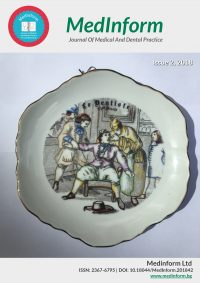Issue Two 2018
2018, Vol. 5 issue 2, (June)
Original Article
Assessment of different types of materials of children treated under general anesthesia
Abstract:
Pharmacological behavior management is necessary for young children with extensive caries (ECC), children with special health care needs and non-cooperative children.
The aim of this study is to assess the different types of materials used for the dental treatment of children under general anesthesia and the average number of extraction according to the age. The retrospective study covered the medical documentation of 395 children (4909 teeth) treated under general anesthesia. The patients are divided in 3 groups according to the age: 0-5 years (3106 teeth); 5-12 years (1568 teeth); 12-18 years (235 teeth). The assessment of extractions and the materials, used for the treatment of children, was done by calculation of the average number of extracted teeth and the teeth, treated by different materials.
Results: The usage of glass – jonomer cement (GJC) are more commonly used filling material in the smallest age group (1-5) years with an average value of 8,035 ± 2,03 filled teeth per child. There is a statistically significant difference in usage of GJC between the different age groups (p = 0.0001). The average number of stainless and zircon crowns are significantly more used in the first age group with an average values of 1,25 ±1,065 per child. Composite restorations are mostly used in the third age group – 4,53 ± 0,046 filled teeth per child. The average number of extractions for all age groups is 3,56 ± 1,52.
Conclusion: In the different age groups of children treated under general anesthesia, different materials are preferred. The restorations are more than the extracted teeth.

